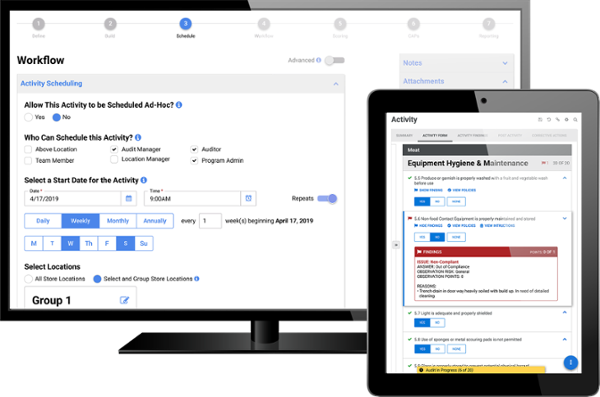In many of our articles, we've covered the benefits of digital transformation and digitizing in restaurant operations. We’ve looked at the principles of HACCP, and ways to improve food safety systems and processes within a retail food establishment for employees and managers, but what about your Above Restaurant Leaders (ARLs)? In this article we, discuss the benefits of performing operational audits and digitizing your internal auditing programs.
The role of above restaurant leaders
The role of an Above Restaurant Leader, within your Above Restaurant Management structure, is critical in driving the financial performance for your restaurants and ensuring they meet their operational objectives. The ARL role requires a varied skill set and background to be successful. ARLs are expected to:
- Act as Business Managers
- Think strategically and execute tactically,
- Identify and fix operational issues and bottlenecks,
- Mitigate risks,
- Support new product launches,
- Watch over product quality and service consistency,
- Develop and train new Restaurant General Managers (RGMs),
- Set and track goals,
- Provide accountability,
- Maintain food safety, regulatory, and brand standards,
- Grow revenue and drive profitability,
- And a bunch of “other stuff” too...
This is no easy task! If you were to analyze your current restaurant operations - would you say your ARLs are operating most efficiently and effectively? As a brand, are you getting the data and insights needed to make decisions and achieve your operational goals? Do you have real-time visibility into what is happening in your restaurants or are you just being reactionary? Are your ARLs spending more time doing manual tasks and paperwork or coaching your RGMs, Crew Leaders, and Crew Members?
If you answered “NO!” to any of these questions… keep reading!
Why digitizing your operational reviews and internal auditing programs are key
In the hyper-competitive world of restaurant chains, there’s constant competition from both established brands and new challengers looking to shake things up and carve out their share of the market (not to mention the rise of Convenience Stores and those Ghost Kitchens everyone is talking about). As a result, it’s easy to get caught up on focusing on what they’re doing, rather than what you’re doing—in a word, you can’t see the forest for the trees.
Consumer preferences are shifting more rapidly than ever before. From quick service restaurants, they want faster service, delivery, loyalty programs, digital kiosks, healthier foods, vegetarian options, crispier fries...the list goes on and on. To serve these needs, operations are continually shifting. They have new processes, new equipment, new suppliers, and new employees, limited time offerings, and new products. Those unwilling to change don’t survive in today’s competitive environment.
At the end of the day, the only thing that matters is how the customer views your team’s performance. While the quality and safety of the food served is obviously the most important aspect of a restaurant’s performance, quality of service comes a close second. So, when two restaurants have relatively similar menus, the customer experience will likely be the determining factor that tips the scales one way or the other.
The importance of operational audits
So what is the best method for measuring and monitoring the ongoing performance of a location? Certainly 3rd party audits and health department inspections provide important checkpoints, but enabling your ARLs to digitally perform operational audits designed to assess their locations, people, and processes frequently, is going to have a higher impact on operational performance.
There are many benefits to ARLs performing periodic operational audits and assessments including:
- When you “measure what matters” it creates an environment where employees know what is expected and creates accountability.
- An additional set of eyes provides an objective “on the ground” look at how a location and the team are performing between the next 3rd Party Audit.
- Frequent assessments can identify operational issues, deficiencies in food safety practices, or inconsistencies in procedures before they become major issues.
- Assessing employees provide coaching opportunities “in the moment”.
- Enables collaboration and problem solving between the ARL and RGM.
- More in depth operational audits provide opportunities to compare their results with any self-assessments (more below) performed by the RGM and/or third-party audits.
All of these reasons provide important opportunities and information needed to drive continuous improvement and consistent customer experience.
What do operational audits typically include?
When assessing restaurant operations and restaurant routines, ARLs are typically looking at a variety of areas including but not limited to:
- Operating Standards
- Operating system execution
- Cash handling
- Brand standards
- Regulatory standards
- Food Safety
- HACCP systems
- Food preparation
- Food storage
- Food holding
- Temperature checks and logs
- Food Quality
- Assembly
- Plating
- Delivery
- Service
- Guest Experience
- Climate
- Wait times
- Greeting
- Service times
- Order accuracy
- Facility
- Promotional items, signage
- Storage
- Kitchen
- Equipment
- Dining room
- Bathrooms
- Exterior
- Playground
- Parking lot
- Landscaping
- Drive-thru
- Security
- Fire suppression
- Employees
- Team appearance
- Hiring (including minors) and documentation
- Staff Development
- Training
- Meals and rest breaks
- Respectful workplace, diversity, and inclusion training
- Time clock integrity
Above restaurant audits + self-assessments + 3rd party audits = location scorecard
As a “best practice,” many of the leading brands also add Self-Assessments to their quality and compliance programs. Self-Assessments can be another crucial element in your pursuit of Operational Excellence and ensuring an optimal Customer Experience.
Even more, when combining Self-Assessments with Operational Audits by your ARL audits and 3rd Party Audits (including Health Department Inspections), brands can get a more complete and balanced picture of how any location is performing on a day-to-day basis and where a location stacks up against your performance KPIs, when leveraging Location Scorecards.
Taking a more holistic view of performance, allow brands to:
- Pinpoint areas where locations meet or fail to meet various brand or regulatory standards.
- Ensure Standard Operating Procedures (SOPs) are being carried out uniformly
- Confirm that the 7 principles of HACCP are being followed
- Measuring manager and employee performance
- Highlighting areas of non-conformance and risk
- Analyzing overall effectiveness of the location
- Identifying locations that are “off-track” in meeting their operational objectives
Data without action is just overhead
Performing all these activities on paper isn’t a bad thing - it’s just not the most optimal. If you are unable to leverage all the data, then you will have difficulty sustaining your improvements over time. Capturing all this information electronically can provide your team with real-time actionable information that your operations team can use to drive continuous improvement. Looking at your operations from multiple angles is a critical component in establishing and maintaining a superior customer experience, which leads to overall business success and growth.
Digitally transforming your quality programs with CMX1

Digitizing all your In Restaurant routines and Above Restaurant auditing programs with ActivityStudio® from CMX1 provides the following benefits:
- Self-Service Authoring Tools - Intuitive, visual Form Building gives your operations and quality teams the tools to digitize any operational audit, self-assessment, or checklist used to measure compliance and drive quality. Self-Service tools allow you to make adjustments on the fly to questions, instructions, policies, and procedures.
- Automated Assignments and Scheduling - In a multifaceted business, it can be overwhelming ensuring the daily, weekly, monthly, quarterly and annual activities are being completed across all your locations. With automated assignments and scheduling, your team can “Set it and forget it” for recurring activities, and more easily monitor task completion and missed assignments.
- Location Specific Content – CMX1 can vary the questions asked in your activities based on the physical attributes of a location. As an example, if a restaurant is in the mall, then there is no need to ask about the parking lot or drive-thru.
- Normalized and consistent data – Smart forms and data validation ensure the information captured is accurate, uniform, and consistent across all activities. Making it vastly easier to analyze and take action on.
- Repeat detection – CMX1 can automatically detect when a restaurant missed a question from a previous audit or assessment. This is incredibly important since it demonstrates whether or not the restaurant has corrected an issue or has a systemic problem.
- Closed-loop Corrective Action Preventative Action (CAPA) – When non-conformances are found, corrective action and preventative actions can be tracked to closure.
- Real time reporting – When data is captured electronically, it can be aggregated and analyzed in real-time. CMX1 provides critical insights and visualizations to show areas of strength and weakness, KPIs, and improvement or decline in performance over time.
- Mobile optimized – Audits, Self-Assessments, Checklists and Inspections can all be done utilizing a web browser or native apps for iOS, Android, or Windows.
Are you interested in leading your restaurants out of the Stone Ages of analog and into the bold future of digital? If so, CMX1 is here to help you navigate the Digital Transformation process. Check out a video overview on ActivityStudio® here.
CMX1 is not just for Above Restaurant Audits. Want to learn more about how CMX1 can be used to modernize your In Restaurant routines? Check out a blog post on the topic here.
Curious what other brands we work with? We have several case studies on brands just like yours who’ve achieved Operational Excellence, and we’re confident we can help you do the same.
Reach out to us today and one of our experts can show you how to get the ball rolling and help you go digital.





